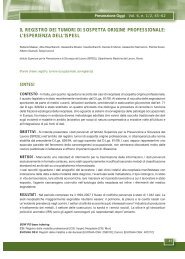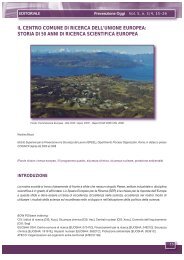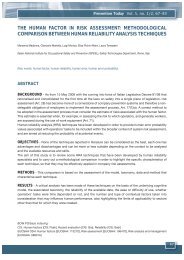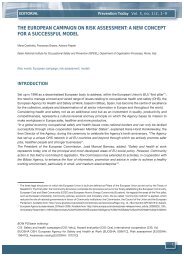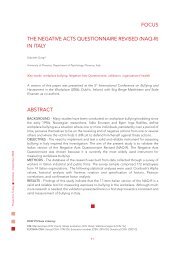Molecular phylogenetic analysis in ... - Prevenzione Oggi
Molecular phylogenetic analysis in ... - Prevenzione Oggi
Molecular phylogenetic analysis in ... - Prevenzione Oggi
You also want an ePaper? Increase the reach of your titles
YUMPU automatically turns print PDFs into web optimized ePapers that Google loves.
Vol. 1, no. 3-4, 69-77<br />
<strong>Molecular</strong> <strong>phylogenetic</strong> <strong>analysis</strong><br />
<strong>in</strong> ecogenotoxicological studies<br />
D. Davolos*,V. Iannilli**, E. De Matthaeis**, B. Pietrangeli*<br />
* ISPESL, Department of Production Plants and Environmental Interaction, Rome<br />
** University of Rome “La Sapienza”, Department of Animal and Human Biology<br />
ABSTRACT<br />
The usefulness of taxa belong<strong>in</strong>g to the Amphipoda (Crustacea) <strong>in</strong> environmental toxicology is welldocumented<br />
<strong>in</strong> literature and a grow<strong>in</strong>g number of studies are address<strong>in</strong>g this l<strong>in</strong>e of research. However, as<br />
with most ecotoxicology studies, this research is rarely supported by analyses of the genetic structure and<br />
evolutionary history of the taxa under exam<strong>in</strong>ation.The availability of such <strong>in</strong>formation becomes crucial<br />
when research is be<strong>in</strong>g carried out on the effects, such as genotoxic ones, of exposure to particular<br />
substances. In this work, two crustaceans (Orchestia garb<strong>in</strong>ii and Gammarus aequicauda;Amphipoda) from<br />
aquatic habitats and with different ecological characteristics were chosen as potential candidates for<br />
ecogenotoxicological assessment for water, as well as for sediments <strong>in</strong> toto. Data are presented on the<br />
genetic structure and on the relationships among populations of these Crustaceans, <strong>in</strong>ferred by us<strong>in</strong>g<br />
sequences of mitochondrial genes. Furthermore, various methods are discussed, which are helpful <strong>in</strong><br />
assess<strong>in</strong>g genotoxicity <strong>in</strong> tissues of organisms exposed <strong>in</strong> the laboratory and <strong>in</strong> populations taken from<br />
contam<strong>in</strong>ated sites.<br />
Prevention Today July - December 2005<br />
69<br />
(Key words: ecogenotoxicology, molecular phylogeny,Amphipoda)<br />
BOW PO/base <strong>in</strong>dex<strong>in</strong>g:<br />
EUOSHA - OSH: Genetic toxicology (26601D), Environmental pollution (05481D), Measurement and assessment<br />
(12561D)<br />
CIS: Ecogenetics (Wopg), Ecotoxicology (Sepe), Crustacea (Fidu),Water pollution (Bubue), Sampl<strong>in</strong>g and <strong>analysis</strong> (Qe)<br />
Reviewed and accepted: 20/02/2006 by Giovanni Alfredo Zapponi; 17/03/2006 by Laura Manc<strong>in</strong>i - National<br />
Institute of Health (ISS)
INTRODUCTION<br />
Prevention Today July - December 2005<br />
70<br />
The development of Community and national norms on the subject of water protection, geared <strong>in</strong>itially<br />
towards the protection of dr<strong>in</strong>k<strong>in</strong>g water, bath<strong>in</strong>g water and of the consumption of edible aquatic<br />
organisms, is currently geared towards an approach of <strong>in</strong>tegrated protection, tak<strong>in</strong>g <strong>in</strong>to account the<br />
necessity to safeguard the entire aquatic ecosystem. In fact, defence of the whole hydric environment from<br />
pollution caused by the <strong>in</strong>troduction of dangerous substances from specific and widespread sources is<br />
necessary <strong>in</strong> order to ensure the protection of human health (e.g. from risks deriv<strong>in</strong>g from the transfer of<br />
contam<strong>in</strong>ants through processes of bioaccumulation and biomagnification).<br />
Criteria for toxicity and ecotoxicity are therefore extremely useful for def<strong>in</strong><strong>in</strong>g environmental quality<br />
standards that are necessary to achieve a good chemical state <strong>in</strong> bodies of water 1-2 . The usefulness of<br />
determ<strong>in</strong>ed taxa <strong>in</strong> environmental toxicology is well-documented <strong>in</strong> scientific literature 3-5 . However,<br />
ecotoxicology studies are rarely supported by analyses of the genetic structure or the evolutionary history of<br />
the taxa under exam<strong>in</strong>ation.The availability of this <strong>in</strong>formation 6-14 turns out to be <strong>in</strong>dispensable when research<br />
is be<strong>in</strong>g carried out on the effects (e.g. the genotoxic effects) from exposure to particular substances 15-22 .<br />
Two Crustaceans belong<strong>in</strong>g to Amphipoda and l<strong>in</strong>ked to aquatic environments were chosen for this study,<br />
as potential candidates for ecogenotoxicological assessment (direct, <strong>in</strong>direct and long-term effects) both for<br />
water and for sediments <strong>in</strong> toto.Analyses were carried out on the talitrid, Orchestia garb<strong>in</strong>ii (Fig. 1), a semiterrestrial<br />
species found along the banks of lakes and rivers <strong>in</strong> Europe, and the gammarid, Gammarus<br />
aequicauda (Fig. 2), found <strong>in</strong> salt water and the lagoon systems of the Mediterranean.<br />
Figure 1 - Orchestia garb<strong>in</strong>ii (Crustacea,Amphipoda,Talitridae): adult male, 20 mm<br />
Figure 2 - Gammarus aequicauda (Crustacea,Amphipoda, Gammaridae): adult male, 15 mm<br />
In this paper, we present <strong>phylogenetic</strong> results on those crustaceans with the focus on gene sequences of<br />
mitochondrial DNA (mtDNA). We will also discuss various methods that are helpful for evaluat<strong>in</strong>g<br />
genotoxicity and mutagenesis <strong>in</strong> tissues of organisms exposed <strong>in</strong> the laboratory and <strong>in</strong> populations taken<br />
from contam<strong>in</strong>ated sites.
1. MATERIALS AND METHODS<br />
The sampl<strong>in</strong>g sites of O. garb<strong>in</strong>ii were: Lake Garda (Verona ) and Lake Bracciano (Rome) (Fig. 3a,b).The<br />
samples of G. aequicauda were taken from the follow<strong>in</strong>g sites: Lake Patria (Caserta); the mouth of the<br />
River Ombrone (Grosseto); the mouth of the River Mignone (Viterbo); the mouth of the River<br />
Candeloro, Manfredonia (Foggia).<br />
Figure 3 - Sampl<strong>in</strong>g sites of Orchestia garb<strong>in</strong>ii: (a) Lake Garda and (b) Lake Bracciano<br />
Lake Garda<br />
(a)<br />
Prevention Today July - December 2005<br />
71<br />
Lake Bolsena<br />
Lake Vico<br />
Lake Bracciano<br />
(b)
The methods used for amplification by Polymerase Cha<strong>in</strong> Reaction (PCR) and the sequenc<strong>in</strong>g of<br />
mitochondrial genes of the subunits I and II of the cytochrome oxidase (COI and COII) 23-5 and of 16S<br />
ribosomal RNA (16S rRNA) are shown <strong>in</strong> 14,26-27 . Homologous sequences of the mtDNA of talitrids 14 (one<br />
sequence is deposited <strong>in</strong> GenBank, NCBI, with access number AY555730), of gammarids 28,29 and of other<br />
Crustacea (extracted from GenBank) were used to carry out <strong>phylogenetic</strong> analyses by the Neighbour-<br />
Jo<strong>in</strong><strong>in</strong>g and Maximum Parsimony methods 14 . <strong>Molecular</strong> <strong>phylogenetic</strong> <strong>in</strong>ferences were carried out by us<strong>in</strong>g<br />
nucleotidic sequences (exam<strong>in</strong><strong>in</strong>g both transitions and transversions) and the deduced am<strong>in</strong>o acid<br />
sequences (with Poisson correction) 14 . From 500 to 1000 bootstrap replications were calculated for each<br />
<strong>phylogenetic</strong> reconstruction 10-14 .<br />
2. RESULTS<br />
Prevention Today July - December 2005<br />
72<br />
Mitochondrial regions encod<strong>in</strong>g prote<strong>in</strong> and ribosomal RNA of O. garb<strong>in</strong>ii and of G. aequicauda were<br />
amplified through the PCR method and then sequenced.The alignments with homologous sequences of<br />
Crustacea generally resulted as unambiguous.The gene tRNA LeuUUR was found between the genes for the<br />
subunits I and II of the cytochrome oxidase (COI and COII) <strong>in</strong> G. aequicauda, while COI-NC-COII 14<br />
rearrangement was found <strong>in</strong> O. garb<strong>in</strong>ii.<br />
Inferences on the evolutionary relationships of O. garb<strong>in</strong>ii and G. aequicauda (potential candidates for<br />
ecogenotoxicological assessment for water as well as for sediments) were obta<strong>in</strong>ed through <strong>phylogenetic</strong><br />
reconstruction us<strong>in</strong>g mitochondrial sequences. Figs. 4 and 5 show some results of a <strong>phylogenetic</strong> <strong>analysis</strong><br />
of the two Amphipods exam<strong>in</strong>ed and of other Crustacea, based on sequences of nucleotides and am<strong>in</strong>o<br />
acids encoded by the COI and COII genes. Fig. 6 shows a <strong>phylogenetic</strong> study of O. garb<strong>in</strong>ii and G. aequicauda<br />
based on nucleotide sequences of ribosomal RNA of the large subunit (16S rRNA).<br />
Figure 4 - <strong>Molecular</strong> phylogeny of O. garb<strong>in</strong>ii, talitrids and other Crustacea (sequences extracted from GenBank)<br />
obta<strong>in</strong>ed through (a) Neighbour-Jo<strong>in</strong><strong>in</strong>g on 121 am<strong>in</strong>o acids (Poisson correction) encoded by a region of the COI<br />
gene and (b) Maximum Parsimony (consensus tree) on 367 nucleotides of the COI gene<br />
56<br />
91<br />
64<br />
80 61<br />
56<br />
90<br />
92<br />
99<br />
99<br />
Panulirus japonicus<br />
Pagurus longicarpus<br />
Penaeus monodon<br />
Orchestia gammarellus (I. Cumbrae)<br />
Orchestia gammarellus (I.Wight)<br />
Orchestia mediterranea (I.Wight)<br />
Talorchestia deshayesii (I.Wight)<br />
Talitrus saltator (I.Wight)<br />
Talitrus ssltator (I. Cumbrae)<br />
Orchestia stephenseni<br />
Orchestia garb<strong>in</strong>ii (L. Garda)<br />
Orchestia garb<strong>in</strong>ii (L. Bracciano)<br />
Parhjale hawaiiensis<br />
Triops cancriformis<br />
Daphnia pulex<br />
Artemia francescana<br />
Tigriopus japonicus<br />
Hyalidae<br />
Talitridae<br />
Talitroidea<br />
0,05<br />
(a)
100<br />
100<br />
100<br />
100<br />
100<br />
100<br />
100<br />
100<br />
66<br />
100<br />
100<br />
100<br />
Triops cancriformis<br />
Daphnia pulex<br />
Artemia francescana<br />
Panulirus japonicus<br />
Penaeus monodon<br />
Pagurus longicarpus<br />
Parhyale hawaiiensis Hyalidae<br />
Orchestia garb<strong>in</strong>ii (L. Garda)<br />
Orchestia garb<strong>in</strong>ii (L. Bracciano)<br />
Orchestia gammarellus (I. Cumbrae)<br />
Orchestia gammarellus (I.Wight)<br />
Orchestia mediterranea (I.Wight)<br />
Orchestia stephenseni (AY555730)<br />
Talitrus saltator (I.Wight)<br />
Talitrus saltator (I. Cumbrae)<br />
Talorchestia deshayesii (I.Wight)<br />
Talitridae<br />
Talitroidea<br />
(b)<br />
Figure 5 - <strong>Molecular</strong> phylogeny of O. garb<strong>in</strong>ii, of G. aequicauda and other Crustacea (sequences extracted from<br />
Genbank) obta<strong>in</strong>ed through Maximum Parsimony (consensus tree) on 114 am<strong>in</strong>o acids encoded by regions of the<br />
COI and COII genes<br />
100<br />
65<br />
89<br />
100<br />
74<br />
62<br />
73<br />
67<br />
66<br />
100<br />
99<br />
94<br />
Daphnia pulex<br />
Triops cancriformis<br />
Pagurus longicarpus<br />
Penaeus monodon<br />
Gammarus aequicauda (Mignone)<br />
Gammarus aequicauda (L. Patria)<br />
Gammarus aequicauda (Ombrone)<br />
Gammarus aequicauda (Candeloro)<br />
Parhyale hawaiiensis Hyalidae<br />
Orchestia garb<strong>in</strong>ii (L. Bracciano)<br />
Orchestia garb<strong>in</strong>ii (L. Garda)<br />
Talitrus saltator (I.Wight)<br />
Talitrus saltator (I. Cumbrae)<br />
Talorchestia deshayesii (I.Wight)<br />
Orchestia gammarellus (I.Wight)<br />
Orchestia gammarellus (I. Cumbrae)<br />
Orchestia mediterranea (I.Wight)<br />
Gammaridae<br />
Talitridae<br />
Talitroidea<br />
Prevention Today July - December 2005<br />
73<br />
Figure 6 - <strong>Molecular</strong> phylogeny of O. garb<strong>in</strong>ii, of G. aequicauda and of other Crustacea (sequences extracted from<br />
GenBank) obta<strong>in</strong>ed through Maximum Parsimony (consensus tree) on 246 nucleotides of the 16S rRNA gene (500<br />
bootstrap replications)<br />
98<br />
74<br />
99<br />
95<br />
100<br />
98<br />
77<br />
100<br />
88<br />
76<br />
Pagurus longicarpus<br />
Penaeus monodon<br />
Gammarus locusta<br />
Gammarus aequicauda (Black Sea)<br />
Gammarus aequicauda (L. Patria)<br />
Gammarus aequicauda (Mignone)<br />
Gammarus balcanicus<br />
Gammarus fasciatus<br />
Gammarus mucronatus<br />
Gammarus annulatus<br />
Gammarus oceanicus<br />
Gammarus elvirae<br />
Gammarus lacustris (L. Hovsgol)<br />
Chaetogammarus mar<strong>in</strong>us<br />
Orchestia garb<strong>in</strong>ii (L. Garda)<br />
Orchestia garb<strong>in</strong>ii (L. Bracciano)<br />
Orchestia “cavimana” (AY744911)<br />
Parhyale hawaiiensis Hyalidae<br />
Gammaridae<br />
Talitridae<br />
Talitroidea
3. DISCUSSION<br />
Prevention Today July - December 2005<br />
74<br />
Many human activities (<strong>in</strong> the <strong>in</strong>dustrial, urban, agricultural sectors, etc.) have caused an <strong>in</strong>crease <strong>in</strong> the<br />
environmental concentration of particular pollutants <strong>in</strong>clud<strong>in</strong>g heavy metals, mutagenic substances, etc.The<br />
negative effects (direct and <strong>in</strong>direct) of xenobiotic agents can be significant <strong>in</strong> natural populations 12-30 , with<br />
a potential risk of exposure and repercussions on human health 31 .<br />
In recent years, many research projects have focussed attention on the identification of species that are<br />
useful <strong>in</strong> ecogenotoxicological assessments on different types of matrices. However, the lack of<br />
<strong>phylogenetic</strong> analyses of the taxa under exam<strong>in</strong>ation may entail a marg<strong>in</strong> of error <strong>in</strong> the <strong>in</strong>terpretation of<br />
the research results, e.g. environmental-genotoxicological 16,17,21,22 .<br />
Low levels of genetic divergence found among the populations of O. garb<strong>in</strong>ii 33-34 validate this organism as a<br />
suitable subject for ecotoxicological <strong>in</strong>vestigation on various geographical scales 21-22-35 . It should be noted<br />
that our research group is <strong>in</strong>volved <strong>in</strong> further molecular studies to exam<strong>in</strong>e populations of O. garb<strong>in</strong>ii and<br />
G. aequicauda sampled <strong>in</strong> other geographical areas, analys<strong>in</strong>g especially the control region of mtDNA<br />
which generally presents hypervariable portions 36 and non-cod<strong>in</strong>g mitochondrial segments 14,37,38 .<br />
Furthermore, studies <strong>in</strong>to genotoxicology 39 and mutagenesis (Fig. 7) are underway on organisms exposed<br />
<strong>in</strong> the laboratory.<br />
Figure 7 - Nucleotidic mutation <strong>in</strong> the COI gene highlighted by sequenc<strong>in</strong>g of mtDNA. (Davolos, study pend<strong>in</strong>g).The<br />
chromatograms are visualized with Chromas software version 1.41<br />
870 880 890 900 910<br />
950 960 970 980
4. CONCLUSIONS<br />
Due to their biological characteristics and the ease with which they may be grown <strong>in</strong> the laboratory 22,40 ,<br />
the O. garb<strong>in</strong>ii and G. aequicauda species analyzed here are particularly suited to experiments on<br />
genotoxicological exposures.<br />
In literature, we can f<strong>in</strong>d various molecular protocols that are used to assess the levels of genotoxicity 18,31,41 .<br />
Among these, the electrophoretic <strong>analysis</strong> of DNA samples <strong>in</strong> agarose gel is useful for the identification and<br />
quantification of the k<strong>in</strong>d of damage caused at DNA level 39,42-45 . In addition, us<strong>in</strong>g <strong>in</strong> vivo and <strong>in</strong> vitro methods<br />
followed <strong>in</strong> DNA sequenc<strong>in</strong>g <strong>analysis</strong>, it is possible to identify any nucleotidic mutations <strong>in</strong>duced 21,22,45 .<br />
Nevertheless, the <strong>in</strong>formation on the genetic structure of the populations exam<strong>in</strong>ed is absolutely<br />
necessary for the <strong>in</strong>terpretation of the results of environmental-genotoxicological studies 15-22 .<br />
REFERENCES<br />
1. Italia. Decreto Legislativo 11 maggio 1999, n. 152.Testo aggiornato del decreto legislativo 11 maggio<br />
1999, n. 152, recante:“Disposizioni sulla tutela delle acque dall’<strong>in</strong>qu<strong>in</strong>amento e recepimento della<br />
direttiva 91/271/CEE concernente il trattamento delle acque reflue urbane e della direttiva<br />
91/676/CEE relativa alla protezione delle acque dall’<strong>in</strong>qu<strong>in</strong>amento provocato dai nitrati provenienti da<br />
fonti agricole”, a seguito delle disposizioni correttive ed <strong>in</strong>tegrative di cui al decreto legislativo18<br />
agosto 2000, n. 258”. Gazzetta Ufficiale n. 246, Supplemento Ord<strong>in</strong>ario n. 172, 20 ottobre 2000.<br />
2. Unione Europea. Direttiva 2000/60/CE del Parlamento Europeo e del Consiglio del 23 ottobre 2000<br />
che istituisce un quadro per l’azione comunitaria <strong>in</strong> materia di acque. Gazzetta ufficiale delle Comunità<br />
europee L327/1-72, 22 dicembre 2000.<br />
3. Schulz R. Us<strong>in</strong>g a freshwater amphipod <strong>in</strong> situ bioassay as a sensitive tool to detect pesticide effects <strong>in</strong><br />
the field. Environ Toxicol Chem 2003;22:1172-6.<br />
4. Schill RO, Kohler HR. Does the environment or the source of the population def<strong>in</strong>e stress status and<br />
energy supply <strong>in</strong> the freshwater amphipod Gammarus fossarum? Ecotoxicology 2004;13:683-95.<br />
5. Borgmann U, Couillard Y, Doyle P, Dixon DG.Toxicity of sixty-three metals and metalloids to Hyalella<br />
azteca at two levels of water hardness. Environ Toxicol Chem 2005;24:641-52.<br />
6. Meyran JC, Monnerot M,Taberlet P.Taxonomic status and <strong>phylogenetic</strong> relationships of some species<br />
of the genus Gammarus (Amphipoda) from mtDNA sequences. Mol Phylogenet Evol 1997;8:1-10.<br />
7. Meyran JC, Gielly L,Taberlet P. Environmental Ca and mtDNA polymorphism among populations of<br />
Gammarus fossarum (Amphipoda). Mol Ecol 1998;7:1391-400.<br />
8. Meyran JC, Taberlet P. mtDNA polymorphism among alp<strong>in</strong>e populations of Gammarus lacustris<br />
(Amphipoda). Freshw Biol 1998;39:259-65.<br />
9. Müller J. Mitochondrial DNA variation and the evolutionary history of cryptic Gammarus fossarum<br />
types. Mol Phylogenet Evol 2000;15:260-8.<br />
10. De Matthaeis E, Davolos D, Cobolli M 1998. Genetic divergence between populations and species of<br />
talitrids from Aegean islands. J Hered 2000;89:37-43.<br />
11. De Matthaeis E, Davolos D, Cobolli M, Ketmaier V. Isolation by distance <strong>in</strong> equilibrium and non<br />
equilibrium populations of four talitrid amphipod species <strong>in</strong> the Mediterranean sea. Evolution<br />
2000;54:1606-13.<br />
12. Davolos D, Ketmaier V, Cobolli M, De Matthaeis E. Struttura genetica e livelli di differenziamento tra<br />
popolazioni e specie di Orchestia (Amphipoda, Talitridae) del Mediterraneo. Biogeographia<br />
2002;23:23-34.<br />
Prevention Today July - December 2005<br />
75
Prevention Today July - December 2005<br />
76<br />
13. Iannilli V, Ketmaier V, Ruffo S, De Matthaeis E. Multidiscipl<strong>in</strong>ary approach to the systematics of the Italian<br />
freshwater Gammarus (Amphipoda). In: Proceed<strong>in</strong>gs of the 4th European Crustacean Conference.<br />
Lodz (Poland); 2002.Abstracts, p. 46.<br />
14. Davolos D, Maclean N. Mitochondrial COI-NC-COII sequences of talitrid amphipods (Crustacea).<br />
Heredity 2005;94:81-6.<br />
15. Hogg ID, Larose C, de Lafonta<strong>in</strong>e Y, Doe KG. Genetic evidence for a Hyalella species complex with<strong>in</strong><br />
the Great Lakes - St. Lawrence River dra<strong>in</strong>age bas<strong>in</strong>: implications for ecotoxicology and conservation<br />
biology. Can J Zool 1998;76:1134-40.<br />
16. Stanton JL, Schizas NV, Chandler GT, Coull BC, Quattro JM. Ecotoxicology and population genetics: the<br />
emergence of phylogepgraphic and evolutionary ecotoxicology. Ecotoxicology 2001;10:217-22.<br />
17. Theodorakis CW. Integration of genotoxic and population genetic endpo<strong>in</strong>ts <strong>in</strong> biomonitor<strong>in</strong>g and<br />
risk assessment. Ecotoxicology 2001;10:245-56.<br />
18. Perk<strong>in</strong>s EJ, Lotufo GR. Play<strong>in</strong>g <strong>in</strong> the mud-us<strong>in</strong>g gene expression to assess contam<strong>in</strong>ant effects on<br />
sediment dwell<strong>in</strong>g <strong>in</strong>vertebrates. Ecotoxicology 2003;12:453-6.<br />
19. Whitehead A, Anderson SL, Kuivila KM, Roach JL, May B. Genetic variation among <strong>in</strong>terconnected<br />
populations of Catostomus occidentalis: implications for dist<strong>in</strong>guish<strong>in</strong>g impacts of contam<strong>in</strong>ants from<br />
biogeographical structur<strong>in</strong>g. Mol Ecol 2003;12:2817-33.<br />
20. Snape JR, Maund SJ, Pickford DB, Hutch<strong>in</strong>son TH. Ecotoxicogenomics: the challenge of <strong>in</strong>tegrat<strong>in</strong>g<br />
genomics <strong>in</strong>to aquatic and terrestrial ecotoxicology.Aquat Toxicol 2004;67:143-54.<br />
21. Davolos D, Pietrangeli B, Maclean N. Mitochondrial DNA sequence <strong>analysis</strong> and molecular phylogeny<br />
of Orchestia cavimana (Crustacea) <strong>in</strong> freshwater genotoxicological studies. In: Proceed<strong>in</strong>gs of the 34th<br />
Annual Meet<strong>in</strong>g of the European Environmental Mutagen society (EEMS 2004). Maastricht, the<br />
Netherlands: University of Maastricht; 2004.Abstracts PW2016.<br />
22. Davolos D, Maclean N, Pietrangeli B. A molecular <strong>phylogenetic</strong> study of the freshwater Orchestia<br />
cavimana (Crustacea). Riv Biol 2004;97:161-8.<br />
23. Capaldi RA.The complexity of a respiratory complex. Nature Struct Biol 1996;3:570-4.<br />
24. Saraste M. Oxidative Phosphorylation at the f<strong>in</strong> de siècle. Science 1999;283:1488-93.<br />
25. Tsukihara T,Aoyama H,Yamashita E,Tomizaki T,Yamaguchi H, Sh<strong>in</strong>zawa-Itoh, et al. Structures of metal<br />
sites of oxidized bov<strong>in</strong>e heart cytochrome c oxidase at 2.8 Å. Science 1995;269:1069-74.<br />
26. Davolos D, Maclean N. Evolutionary relationships among supralittoral talitrid amphipods (Crustacea)<br />
<strong>in</strong>ferred from mitochondrial sequence <strong>analysis</strong>. In: Proceed<strong>in</strong>gs of the “XXI Giornata dell’Ambiente.<br />
Aree costiere”. Roma, Italy:Accademia Nazionale dei L<strong>in</strong>cei. [2004];205:233-42.<br />
27. Müller JC, Schramm S, Seitz A. Genetic and morphological differentiation of Dikerogammarus <strong>in</strong>vaders<br />
and their <strong>in</strong>vasion history <strong>in</strong> Central Europe. Fresh Biol 2002;47:2039-48.<br />
28. Macdonald KS III,Yampolsky L Duffy JE. <strong>Molecular</strong> and morphological evolution of the amphipod<br />
radiation of Lake Baikal. Mol Phylogenet Evol 2005;35:323-43.<br />
29. Iannilli V, De Matthaeis E. Genetic divergence with<strong>in</strong> Gammarus aequicauda (Martynov, 1931) based<br />
on 16S mitochondrial DNA. In: Proceed<strong>in</strong>gs of The Sixth International Crustacean Congress.<br />
Glasgow, Scotland UK: University of Glasgow; 2005.<br />
30. Wurgler FE, Kramers PG. Environmental effects of genotox<strong>in</strong>s (eco-genotoxicology). Mutagenesis<br />
1992;7:321-7.<br />
31. Jha AN. Genotoxicological studies <strong>in</strong> aquatic organisms: an overview. Mutat Res 2004;552:1-17.<br />
32. Sato H, Aoki Y. Mutagenesis by environmental pollutants and bio-monitor<strong>in</strong>g of environmental<br />
mutagens. Curr Drug Metab 2002;3:311-9.
33. De Matthaeis E, Ketmaier V, Latella L, Ruffo S, Scap<strong>in</strong>i F,Tarocco M. Multidiscipl<strong>in</strong>ary approach to the<br />
study of a terrestrial Amphipod: the case of Orchestia cavimana. In: Proceed<strong>in</strong>gs of the IV European<br />
Crustacean Conference. Lodz, Poland; 2002.Abstracts 36.<br />
34. Ketmaier V,Amendola D, Scap<strong>in</strong>i F, De Matthaeis E. Large scale phylogeography of the landhopper<br />
Orchestia cavimana: comb<strong>in</strong><strong>in</strong>g allozymes and mtDNA. In: Proceed<strong>in</strong>gs of the XIth International<br />
Colloquium on Amphipoda.Tunis; 2003.<br />
35. Fialkowski W, Ra<strong>in</strong>bow PS, Smith BD, Zmudz<strong>in</strong>ski L. Seasonal variation <strong>in</strong> trace metal concentrations <strong>in</strong><br />
three talitrid amphipods from the Gulf of Gdansk, Poland. J Exp Mar Biol Ecol 2003;288:81-93.<br />
36. Chu KH, Li CP,Tam YK, Lavery S.Application of mitochondrial control region <strong>in</strong> population genetic<br />
studies of the shrimp Penaeus. Mol Ecol Notes 2003;3:120-2.<br />
37. Davolos D, Iannilli V, De Matthaeis E.Analysis on the mitochondrial region between the COI and COII<br />
genes <strong>in</strong> Crustacea. In: Proceed<strong>in</strong>gs of The Sixth International Crustacean Congress. Glasgow,<br />
Scotland UK: University of Glasgow; 2005.<br />
38. Davolos D, Iannilli V, De Matthaeis E. <strong>Molecular</strong> <strong>analysis</strong> on the mitochondrial COI-tRNALeuUUR-<br />
COII region <strong>in</strong> Gammarus aequicauda (Amphipoda, Gammaridae). In: Proceed<strong>in</strong>gs of the First<br />
Congress of Italian Evolutionary Biologists. Ferrara, Italy: University of Ferrara; 2005.<br />
39. Set<strong>in</strong>i A, Iannilli V. DNA strand breakage come biomarker di esposizione ai metalli. In: Proceed<strong>in</strong>gs of<br />
the 66th Annual Congress of the U.Z.I. 19-22 Sept 2005. Roma, Italy: 2005.<br />
40. Hecker A, Quennedey B,Testeniere O, Quennedey A, Graf F, Luquet G. Orchest<strong>in</strong>, a calcium-b<strong>in</strong>d<strong>in</strong>g<br />
phosphoprote<strong>in</strong>, is a matrix component of two successive transitory calcified biom<strong>in</strong>eralizations<br />
elaborated by a terrestrial crustacean. J Struct Biol 2004;146:310-24.<br />
41. Lee RF, Ste<strong>in</strong>ert S. Use of the s<strong>in</strong>gle cell gel electrophoresis/comet assay for detect<strong>in</strong>g DNA damage <strong>in</strong><br />
aquatic (mar<strong>in</strong>e and freshwater) animals. Mutat Res 2003;544:43-64.<br />
42. Costa FO, Neuparth T, Costa MH,Theodorakis CW, Shugart LR. Detection of DNA strand breakage<br />
<strong>in</strong> a mar<strong>in</strong>e amphipod by agarose gel electrophoresis: exposure to X-rays and copper. Biomarkers<br />
2002;7:451-63.<br />
43. Dixon DR, Pruski AM, Dixon LR, Jha AN. Mar<strong>in</strong>e <strong>in</strong>vertebrate eco-genotoxicology: a methodological<br />
overview. Mutagenesis 2002;17:495-507.<br />
44. Park S, Imlay JA. High levels of <strong>in</strong>tracellular cyste<strong>in</strong>e promote oxidative DNA damage by driv<strong>in</strong>g the<br />
fenton reaction. J Bacteriol 2003;185:1942-50.<br />
45. Braman J (ed.). In Vitro Mutagenesis Protocols. 2nd Edn.Totowa NJ: Humana Press; 2002.<br />
Prevention Today July - December 2005<br />
77



